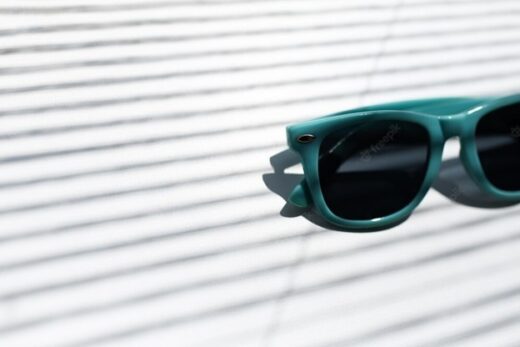Architecture of glasses, Ray-Ban prescription eyewear lenses fashion, Eye UV protection
The Architecture of Glasses
16 July 2024
Glasses, once purely a tool for correcting vision, have morphed into much more—now they’re a blend of personal style, cutting-edge technology, and architectural innovation. The design of glasses, akin to the design of buildings, marries form and function, creating objects that are both practical and visually appealing.
This article delves into the intricate architecture of glasses, exploring their evolution, materials, and design principles, with a spotlight on the legendary Ray-Ban prescription glasses.
The Evolution of Glasses
The journey of glasses dates back to ancient times, with early versions found in Roman and Greek civilizations. Yet, it wasn’t until the 13th century that spectacles resembling today’s glasses began to appear. These early designs were quite rudimentary, with frames crafted from wood or bone and lenses made of quartz or glass. Over the centuries, both the design and materials of glasses have undergone significant transformations, reflecting the ever-changing needs and tastes of society.
Materials: From Wood to High-Tech Polymers
The choice of materials in the construction of glasses dramatically influences their functionality and aesthetics. Traditional materials like wood, bone, and metal have evolved into more advanced options, including high-tech polymers and lightweight alloys. These modern materials not only offer superior durability and comfort but also provide greater design flexibility.
Metal Frames
Metal frames, typically crafted from stainless steel, titanium, or aluminum, are renowned for their strength and durability. These materials are lightweight and resistant to corrosion, making them ideal for everyday wear. Titanium, in particular, is prized for its hypoallergenic properties and ability to withstand extreme conditions, making it a popular choice for both fashion and sports eyewear.
Plastic Frames
Plastic frames, often made from acetate or TR-90, offer a diverse array of colors and styles. Acetate, derived from plant-based materials, is celebrated for its versatility and comfort. It can be molded into various shapes and dyed in numerous colors, allowing for endless design possibilities. TR-90, a thermoplastic material, is known for its flexibility and impact resistance, making it an excellent choice for active lifestyles.
Natural Materials
Recently, there has been a resurgence in the use of natural materials like wood, bamboo, and horn. These materials are cherished for their unique textures and eco-friendly attributes. While they require more care and maintenance than synthetic options, they offer a distinctive look that appeals to environmentally conscious consumers.
Design Principles: Balancing Form and Function
Designing glasses involves a delicate balance between form and function. Much like architects, eyewear designers must consider ergonomics, aesthetics, and technological advancements to create products that meet the diverse needs of wearers.
Ergonomics
Ergonomics is a critical aspect of eyewear design. Glasses must fit comfortably on the face, distribute weight evenly, and avoid causing pressure points. This requires careful consideration of factors such as bridge design, temple length, and lens size. Adjustable nose pads and spring hinges are common features that enhance comfort and fit.
Aesthetics
Aesthetics play a significant role in the appeal of glasses. Designers draw inspiration from various sources, including art, fashion, and architecture, to create frames that resonate with wearers. The shape, color, and texture of frames can express individuality and complement personal style. For instance, the classic wayfarer design, popularized by Ray-Ban, has become a timeless icon in eyewear fashion.
Technological Advancements
Advancements in lens technology have revolutionized the functionality of glasses. High-definition lenses, anti-reflective coatings, and blue light filters enhance visual clarity and protect eyes from digital strain. Prescription glasses, in particular, benefit from these innovations, providing wearers with customized solutions for their vision needs.
Ray-Ban Prescription Glasses: A Fusion of Heritage and Innovation
Ray-Ban, a name synonymous with timeless style and quality, has been at the forefront of eyewear design since its inception in 1937. Known for its iconic models like the Aviator and Wayfarer, Ray-Ban has continually evolved to meet the needs of modern consumers. Their prescription glasses combine classic designs with cutting-edge lens technology, offering wearers both style and functionality.
Ray-Ban prescription glasses are crafted with the same attention to detail and quality as their non-prescription counterparts. The frames are available in various materials, including metal, acetate, and high-performance alloys, ensuring durability and comfort. Ray-Ban’s innovative lens options cater to different vision needs, providing sharp, clear vision in any setting.
Architecture of glasses Conclusion
The architecture of glasses is a fascinating blend of art, science, and craftsmanship. From the choice of materials to the intricacies of design, every element contributes to the creation of eyewear that enhances both vision and style.
Brands like Ray-Ban exemplify this symbiosis, offering products that are as functional as they are fashionable. As we continue to push the boundaries of design and technology, the future of eyewear promises even more exciting innovations, ensuring that glasses remain an essential accessory for both vision and fashion.
Comments on this guide to Architecture of glasses, Ray-Ban eyewear article are welcome.
Optical Shops – Eyewear Stores
Contemporary Optical Shop Designs – Glasses and Sunglasses Stores – selection from e-architect
How to design an optical shop guide
Optica Lazzarini in Villa Carlos Paz, Córdoba shop
Glassworks Eyewear Gallery and Optometry Clinic
Óptics Lafuente Pontevedra store, Spain optical shop
Lumea eye care boutique, Toronto, Ontario
Shopping
Shop Buildings
Maximo Shopping Center in Rome, Italy
Architects: Design International
Sunglasses brands
Sunglasses brand articles
Types of prescription sunglasses

Comments / photos for the Architecture of glasses, Ray-Ban prescription eyewear page welcome.








